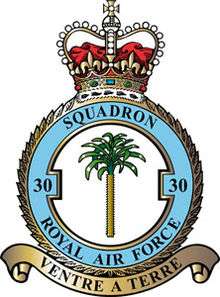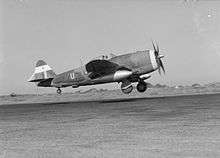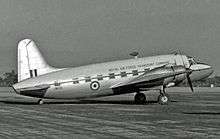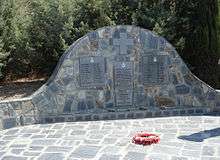No. 30 Squadron RAF
| No. 30 Squadron RAF | |
|---|---|
 30 Squadron badge | |
| Active |
24 March 1915 – 1 December 1946 November 1947 – September 1967 June 1968 – present[1] |
| Role | Air transport |
| Garrison/HQ | RAF Brize Norton |
| Motto(s) |
French: Ventre a terre "All out" |
| Equipment | C-130 Hercules |
| Battle honours | see below |
| Insignia | |
| Identification symbol | A date palm tree |
No. 30 Squadron of the Royal Air Force operates the second generation C-130J Hercules from RAF Brize Norton, Oxfordshire. The squadron operates alongside No. 24 Squadron and No. 47 Squadron all flying the Hercules.
History
First World War
No. 30 Squadron was formed for service in Egypt in October 1914 at Farnborough, but was not allocated the squadron number 30 until 24 March 1915. Initially a single flight of BE2s at Ismailia Airfield.
On 24 August 1915, the Mesopotamian Half Flight, a unit of the Australian Flying Corps (AFC) stationed in Mesopotamia (Iraq) was formally attached to 30 Sqn. For several months the Half-Flight, under Captain Henry Petre, had been flying operations in support of the Indian Army, against Turkish ground forces, during the Mesopotamian campaign. In early 1915, the Australian Government received a request for assistance for air support from the British Government of India. The AFC was still in its infancy and could only provide enough aircrews and ground staff for half a flight. All aircraft were to be provided by the Indian Government. Captain Henry Petre was appointed commander, before the half-flight sailed for Bombay. The Australians were augmented by personnel from the Indian Army and New Zealand.
On 20 April, the half-flight left India for Mesopotamia (Iraq) to provide air support to Indian and British troops against the Ottoman Empire (Turkey). The unit was officially known as the
Upon its arrival in Basra on 26 May, the half-flight took delivery of two Maurice Farman Shorthorns and a Maurice Farman Longhorn. These three biplanes were of a "pusher" design, so-called because the propeller faced backwards, behind the cockpit and were already obsolete. In particular, they were not suitable for desert conditions: their top speed was only 50 mph (80 km/h), while the wind (known locally as the shamal) often reached 80 mph (129 km/h). Secondly, the warmer air reduced aerodynamic lift, rendering the Farmans unable to take off on some occasions. In addition, the Longhorn was a second-hand aircraft with persistent mechanical problems, meaning that it spent many hours undergoing maintenance.
Nevertheless, the half-flight was immediately put to use on reconnaissance missions. Shortly afterwards, the Indian Army captured the town of Amarah, and the half-flight moved there on 9 June.
On 4 July, the half-flight's equipment was augmented with two Caudron G.3 aircraft, which were still not up-to-date, but generally preferred to the Farmans. On 30 July, one of the Caudrons was forced to land in enemy territory due to mechanical problems. It was later reported that the crew — Lieutenants George Pinnock Merz and W. W. A. Burn (a New Zealander) — were killed by armed civilians in a running gun battle, over several miles. They were Australia's first military aviation casualties. The main body of 30 Sqn remained in Egypt for several weeks.
During September, the obsolescent Maurice Farmans operated by the Australians were supplemented by three Royal Naval Air Service (RNAS) Short 827 floatplanes and their crews, under Squadron Commander Robert Gordon. Because the Tigris river was too shallow for the seaplanes to use at that time of year, they were converted into wheeled aircraft. On 27 September, Kut was captured and the Half-Flight moved there.
In October, four BE2c and their RFC crews arrived in Mesopotamia. With the Australians they were designated "B" Flight of 30 Sqn.
The flight suffered an increasing number of losses with at least two crews being taken prisoner, after being shot down or suffering engine failure. The Indian Army met with stiff opposition outside Baghdad, and were forced back to Kut on 4 December, where the city was besieged. Ottoman forces eventually broke through and nine Australian ground staff from the half-flight became prisoners of war. Like the rest of the Allied POWs, AFC personnel taken prisoner in Mesopotamia endured a punishing forced march to Turkey proper and only four of them survived captivity.
By 7 December, Petre was the only Australian airman remaining in Mesopotamia, left No. 30 Squadron and flew the only remaining Shorthorn to Egypt. He and it were incorporated into the first full squadron to be formed by the Australian Flying Corps: No. 1 Squadron AFC.
After breaking out of Kut, Allied forces met with stiff opposition outside Baghdad, and were forced back to Kut on 4 December, where they were again besieged. Ottoman forces eventually broke through and nine AFC ground staff became prisoners of war. Like the rest of the Allied POWs, they endured a punishing forced march to Turkey and only four of them survived captivity.
In April 1916, the squadron carried out one of the earliest air supply mission when it air-dropped food and other supplies to the garrison at Kut which was besieged by the Turks.
The rest of 30 Sqn carried out bombing and reconnaissance missions until the end of the war with a variety of aircraft including SPADs, DH-4s and RE.8s.
1920s & 1930s
In 1919 the squadron was sent to Iran as part of the Norperforce.[2] This was followed by a posting to Iraq, for which it was re-equipped with DH.9As but by 1929 these in turn had been replaced by Westland Wapitis followed by Hawker Hardys (a tropicalised, general purpose version of the Hawker Hart light bomber) in 1935 and Blenheim Is in 1938.
Second World War
In August 1939, as war loomed, the squadron moved back to Egypt and carried out escort missions in the Western Desert and provided fighter defence of Alexandria. In November 1940, it was sent to Greece to operate its Blenheims in both the bomber and fighter roles, but in March 1941 the squadron was redesignated a fighter unit. After the fall of Greece and the Battle of Crete the squadron returned to Egypt and was re-equipped with Hurricanes and employed on night defence of Alexandria and then moved on to operations in the Western Desert.

When the situation in the Far East worsened the squadron was transferred to Colombo Racecourse Airstrip in Ceylon arriving on 6 March 1942, just in time to assist in resisting the Japanese carrier strike against the island in early April.
In February 1944 it moved to the Burma front flying escort and ground attack missions and in May 1944 was re-equipped with American Republic P-47 Thunderbolts, which it took back into action in October until May 1945.
Post-war
After the Japanese surrender the squadron remained in India and its Thunderbolts were replaced by Hawker Tempest F Mk 2s in March 1946. It was disbanded on 1 Dec 1946.

On 24 November 1947 the squadron was reformed at RAF Oakington, Cambridgeshire in the transport role, operating as a unit within the Royal Air Force Transport Command. It flew the Dakota on many humanitarian supply flights during the Berlin Airlift. Re-equipment with the Vickers Valetta came in December 1950. The heavier four-engine Blackburn Beverley was flown between April 1957 and September 1967. The Squadron temporarily disbanded in September 1967 but quickly reformed at RAF Lyneham equipped with turbine-propeller powered Lockheed Hercules transports, maintaining the units transport role.
Today

The RAF transport fleet is in a period of flux and the Hercules C4/C5 fleet is a major part of this. The RAF ordered 25 of the aircraft with first deliveries in 1999.
During 2008 'A' flight was based at RAF Al Udeid with the Hercules C.4.[3]
The first generation Hercules C1/C3 fleet is due to be replaced by 25 Airbus A400Ms at which time RAF Lyneham closed. This will see RAF's transport aircraft concentrated at RAF Brize Norton with the C-17 and tanker fleets.
Aircraft operated
- Farman Longhorn 1915
- Farman Shorthorn 1915–1916
- Voisin LA.S 1915
- Henry Farman F27 1915
- Caudron G.3 1915
- Royal Aircraft Factory B.E.2 1915–1917
- Royal Aircraft Factory R.E.8 1917–19
- Airco D.H.9 1921–1929
- Westland Wapiti 1929–1935
- Hawker Hardy 1935–1938
- Bristol Blenheim 1938–1941
- Hawker Hurricane 1941–1944
- Republic Thunderbolt 1944–1946
- Hawker Tempest F2 1946
- Douglas Dakota 1947–1950
- Vickers Valetta 1950–1957
- Blackburn Beverley 1957–1967
- Lockheed Hercules 1968–present
Battle honours
- On the squadron standard
Egypt, 1915: Mesopotamia, 1915–1918: Egypt & Libya, 1940–1942: Greece 1940–1941, Mediterranean, 1940–1941, Ceylon April, 1942: Arakan, 1944: Burma 1944–45
- Others
Iraq, 1919–1920: North West Persia, 1920: Kurdistan, 1922–1924: Iraq, 1923–1925: Iraq, 1928–1929: Kurdistan, 1930–1931: Northern Kurdistan, 1932: Gulf, 1991
Memorials

There is a Royal Air Force (RAF) memorial in Crete to the airmen of 30 and 33 Squadrons who died during the Battle of Crete. The memorial is located (35°31′31″N 23°49′43″E / 35.525363°N 23.828619°E) behind the roadside hedge between Maleme and Tavronitis overlooking the (35°31′36″N 23°49′32″E / 35.526625°N 23.825604°E[4]) Iron Bridge across the Tavronitis River and the end of Maleme Airport runway.
References
- Citations
- ↑ Air of Authority
- ↑ Cecil John Edmonds (2009), East and West of Zagros, Brill Academic Publishers, OCLC 593346009
- ↑ Cotter 2008, p. 34.
- ↑ http://wikimapia.org/#lat=35.526625&lon=23.825604&z=17&l=0&m=a&v=2
- Bibliography
- Cotter, Jarrod (2008). Royal Air Force celebrating 90 years. Stamford, UK: Key Publishing Ltd. ISBN 978-0-946219-11-7.
- Hamlin, John F. Flatout – The Story of 30 Squadron Royal Air Force. Tunbridge Wells, Kent, UK: Air-Britain (Historians) Ltd., 2002. ISBN 0-85130-308-0.
- de Normann, Roderick. "Mespot Squadron: No 30 Squadron in Mespotamia 1916–1917". Air Enthusiast, No. 66, November – December 1996. Stamford, Lincs, UK: Key Publishing. ISSN 0143-5450.
- "Sqn Histories 26–30". Air of Authority – A History of RAF Organisation. rafweb.org.
External links
| Wikimedia Commons has media related to No. 30 Squadron RAF. |